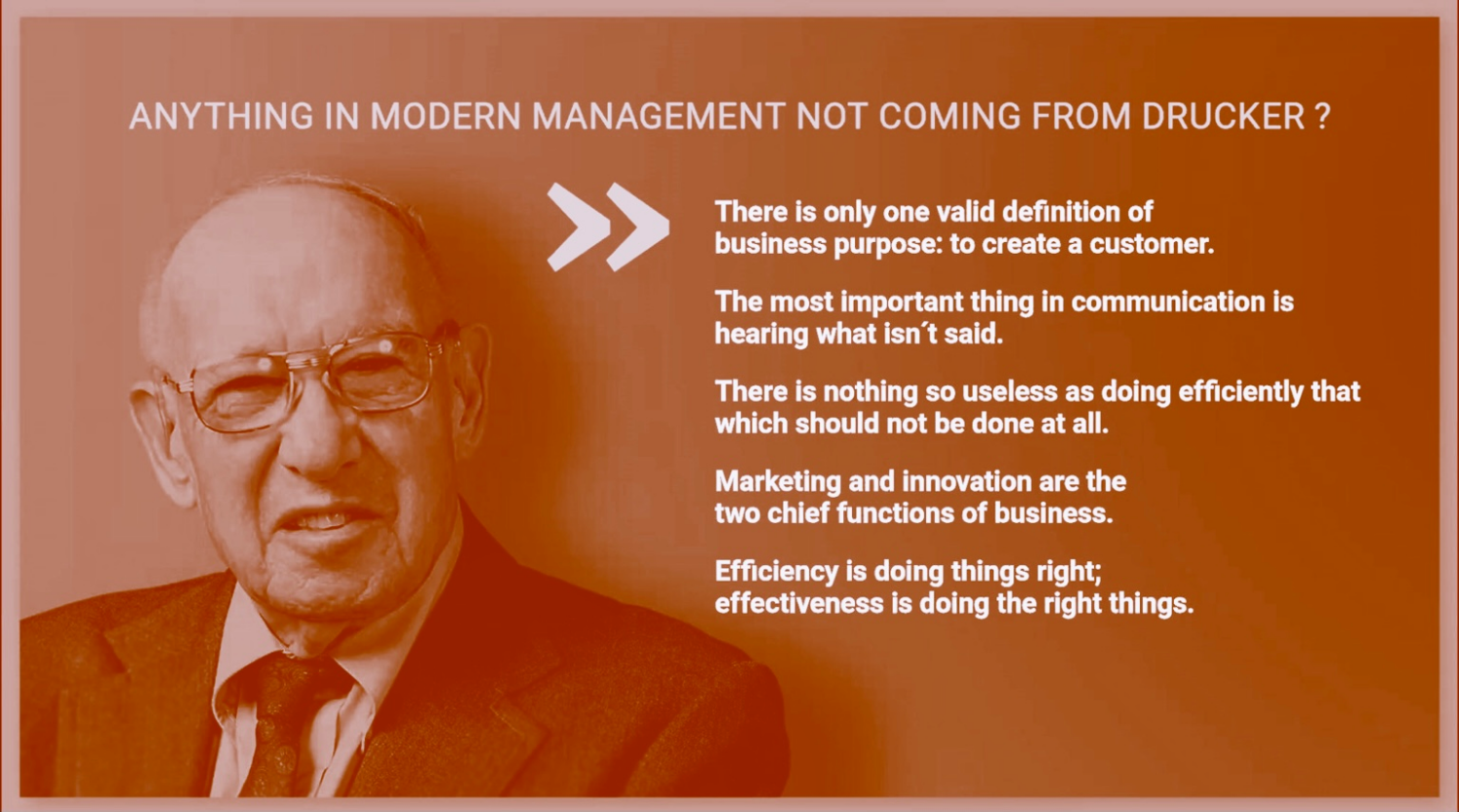Inside Drucker’s Brain – the true essence of management
Peter F. Drucker is a role model to me.
His ideas and thoughts are the blueprints for all other management books. I often say: “You don’t need to have read more than Drucker”.
Drucker embodies the true essence of management. Drucker lived a life based on embracing tomorrow and giving up yesterday. In the process, he discovered an important paradox: in order to build something, you have to tear it down. Drucker had no problem tearing things down, giving up what didn’t work and leaving behind what no longer mattered. He could achieve so much that way.
In principle, this is also what interim management is all about and this is also reflected in my claim: MOVE | CHANGE | CONNECT
At the end of 2003, 94-year-old Peter F. Drucker invited the author Jeffrey A. Krames to his home for a full-day interview. He spoke openly about his groundbreaking management principles, his enormous body of work (38 books over six decades) and the leaders he has advised over the years (e.g. Jack Welch).
It took Krames many months to transcribe the more than six-hour interview, but it took him years to process it.
I recommend everyone to read the book by Jeffrey A. Krames: “Inside Drucker’s Brain” it gives readers a new perspective on the thought patterns of this extraordinary mastermind.
Here you can read text excerpts and quotes from the book:
“Management is doing things right. Leadership is doing the right things.”
The born Manager
- can place people
- can hire or fire people without getting emotionally upset
- decides priorities
One of Drucker’s prescient business tenets is: „AlI development is self-development.“ This means that it is every individual’s responsibility to do whatever is necessary to gain the mind-set, training, and initiative to grow professionally. The key is to do that by focusing on strengths. Here are seven ideas on how to do that, excerpted directly from Drucker’s writings:
- List your major contributions over the last two to three years.
- Make a list of the four to six specific tasks and responsibilities that you are most accountable for at your company.
- Ask for the most demanding assignments.
- Examine the best in yourself before searching out the best in others.
- Do not fear strong colleagues or ambitious subordinates.
- Don’t resent talent-surround yourself with the best.
- Become a genuine doer and do not waste energy putting others down.
“Don’t tell me what you are doing. Tell me what you stopped doing.”
THE CRITICAL FACTORS
Just as there are “no leadership qualities,” there is no one critical factor. „Leadership is doing the right things,“ and that entails many factors. We do know that Drucker’s ideal leader had the following traits and habits:
- Possesses character and courage: these are two of the most fundamental characteristics of a leader.
- Creates a clear mission: a leader paints a clear picture of the finish line.
- Installs loyalty: a leader understands that loyalty is a two-way street.
- Focuses on strength: a leader makes “strengths effective and weaknesses irrelevant”
- Does not fear strong subordinates: their successes are your successes.
- Is consistent: leadership is not a function of being clever, it is based on consistency.
- Develops tomorrow’s leaders: the best leaders understand that it is their responsibility to develop leaders who will guide their organization in the years ahead.
“No institution can possibly survive if it needs geniuses or supermen to manage it.”
“In the modern corporation, the problem of leadership is not only more important than in other institutions, it is far more difficult. The modern industrial enterprise needs many more leaders than institutions, and of high quality. At the same time, it does not automatically produce leaders either in sufficient numbers or of sufficient quality and experience. Leadership cannot be created or promoted. It cannot be taught or learned … management cannot create leaders. It can only create the conditions under which potential leadership qualities become effective; or it can stifle potential leadership.”
The three officers’ rule:
A responsible CEO should identify, within three years of accepting the position, and have available at least three candidates equal or better than himself who can succeed him should the need arise.
“Any business enterprise has two — and only these two — basic functions: marketing and innovation.”
Leaders subordinate themselves to the task, but don’t identify themselves with the task. The task remains both bigger than they are, and different. The greatest indictment of a leader is that the organization falls apart the day he or she leaves. „He or she hasn‘t built. They may have been effective operators, but they have not created vision”. Leaders must learn to become servants to whatever task the organization needs to perform.
“Without a decision maker you’ll never make a decision.”
Life-and-death Decisions:
There are no decisions more important than people decisions. Drucker never forgot the lessons he had gleaned from Alfred Sloan. “Executives spend more time on managing people and making people decisions than on anything else—and they should,” insisted Drucker. “No decision is as long lasting in its consequences or as difficult to unmake. He added that most executives make bad people decisions, with a batting average no better than 0,333: one third of new hires are good ones; one third are “minimally effective,” and one third are disasters.

Source: Peter Drucker Society
Obsess over Customers:
“It is the customer who determines what a business is. For it is the customer, and he alone, who through being willing to pay for a good or a service, converts economic resources into wealth, things into goods. What the business thinks it produces is not of first importance— especially not to the future of the business and to its success. What the customer thinks he is buying, what he considers value/ is decisive—it determines what a business is, what it produces and whether it will prosper. The customer is the foundation of a business and keeps it in existence. He alone gives employment.“
On the information revolution (1999):
“The truly revolutionary impact of the Information Revolution is just beginning to be felt. But it is not ‘information’ that fuels this impact. It is not artificial intelligence.’ It is not the effect of computers … on decision-making policymaking, or strategy. It is something that practically no one foresaw, or even talked about ten or fifteen years ago—that is, the explosive emergence of the Internet as a major, perhaps eventually the major, worldwide distribution channel for goods, for services, and, surprisingly, for managerial and professional jobs. This is profoundly changing economies, markets and industry structures; products and services and their flows; consumer segmentation, consumer values, and consumer behaviour; jobs and labour markets. But the impact may be even greater on societies and politics, and, above all, on the way we see the world and ourselves in it.”
“BUSINESS ALONE IS DESIGNED TO INNOVATE. No business will long survive, let alone prosper, unless it innovates successfully.”
What Will Our Business Be? (Mid-1950s):
“The customer is the foundation of the business and keeps it in existence. “Because its purpose is to create a customer any business enterprise has two—and only these two—basic functions: marketing and innovation. They are the entrepreneurial functions.
The lesson is, don’t wait to innovate. Innovate outside the existing organisation. You may set up an innovation kindergarten. The key is to make sure to organize for innovation. If you don’t look out the window, you won’t see it. Tomorrow always arrives. It Is always different. And then even the mightiest company is in trouble if it has not worked on the future. It will have lost distinction and leadership. (Long before Grove’s “strategic inflection point” and Christensen’s “disruptive technology” became parts of the business lexicon, there was Peter Drucker, warning of similar Perils but using less lofty terms).
Last but not least, Drucker also commented on his profession as a consultant (he never held an operational management position):..
.
“The clients pay for the consultant’s mistakes.”
.
.
Source: Jeffrey A. Krames: Inside Drucker’s Brain, Portfolio Hardcover (2008).
.
.
Click here for a reading sample:
I SUPPORT YOU ON THE WAY TO YOUR SUCCESS
I am a strategist, an innovator, an unconventional thinker, a mover and shaker and therefore I do the right things sooner and better.
And with pleasure also for you.
Together we can discover new market opportunities, steer product branding into the right direction, understand your customers better – and stand out from the competition with tailor-made products for your target group. All this leads to more customer satisfaction, greater customer lifetime value and more sales potential.
Can you afford not to go for it?






